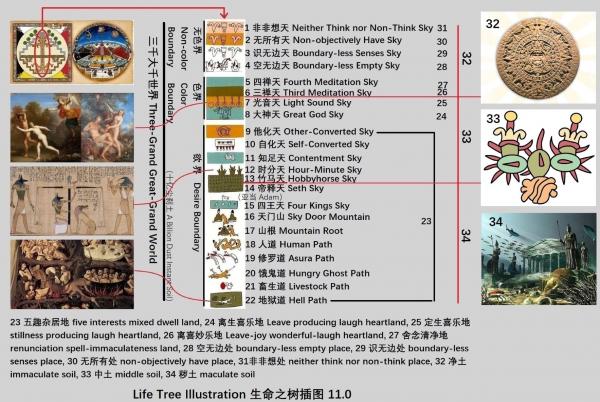| 11.4.2-3 受蘊和想蘊 Acceptance Node and Think Node |
| 送交者: 盧岩 2023年06月29日05:38:12 於 [教育學術] 發送悄悄話 |
11.4.2 受蘊 Acceptance Node受是心地法(參見後文的心所有法)之一的受法,是領納的感受,接收義。能接收的是人,而所接收到的是受。受蘊是有情眼耳鼻舌身意六識對苦樂等受習氣的積聚體總和。 Acceptance, means “the act of taking or receiving something offered”, is one of “omnipresent heartland laws” (detailed explanation refers to Migration Node). The capable of receiving is human; the being received is “the feeling state of being received”. Sentient eye, ear, nose, tongue, body, and Intent-sense (i.e., consciousness), the six senses, each has an accumulative body of laugh, bitter etc. receiving habits; Accepting Node is the sum of the six receiving karmic bodies (i.e., six accumulated bodies of receiving habits).
受能生起欣求的愛欲,有五種:苦受、樂受、憂受、喜受、和舍受。 Acceptance can generate desire for love, can be sorted into five categories: bitter acceptance, laugh acceptance, renunciative acceptance, gloomy acceptance, delightful acceptance. (1) 苦受,領受違逆境相時,身心受到逼迫,以身識作為心來說,這逼迫名苦受。 Bitter Acceptance, when receiving adverse environment, body and heart feel being forced; with body-sense as heart (i.e., mind), the “feeling of being forced” is Bitter Acceptance. (2) 樂受,領受適順境相時,身心適悅,以身識作為心來說,這適悅名樂受。 Laugh Acceptance, when receiving suitable or beneficial environment, body and heart are pleased, delighted; with body-sense as heart, the happiness is named as Laugh Acceptance. (3) 憂受,領受違逆境相時,身心受到逼迫,以意識作為心來說,這逼迫名憂受。 Gloomy Acceptance, when receiving adverse environment, body and heart feel being forced; with Intent (i.e., preconscious) as heart, the “being forced” is named as Gloomy Acceptance. (4) 喜受,領受適順境相時,身心適悅,以意識作為心來說,這適悅名喜受。 Delightful Acceptance, when receiving adoptable or beneficial environment, body and heart are pleased, delightful; with Intent (i.e., preconscious) as heart, the “enjoyable delight” is named as Delightful Acceptance. (5) 舍受,領受中庸境相時,於身心非適悅非逼迫,名不苦不樂受,即是舍受。因為人遇到不苦不樂受的中庸感受時,總是選擇放棄、離開,所以此種受被命名為舍受。 Renunciative Acceptance, when receiving neutral, neither adoptable nor adverse environment, body and heart are neither enjoyable delightful nor being forced, that is named as “neither bitter nor laugh acceptance”, what Renunciative Acceptance is. Because when a human meets “neither laugh nor bitter acceptance”, the neutral feeling, intents to abandon, gives up, leaves, therefore, the kind of acceptance is named Renunciative Acceptance. 眼耳鼻舌身,這前五識與樂受、舍受、和苦受相應。第六識(意識)與這五種受都相應。第七識(即前意識、末娜、玉女、夏娃)與憂受、舍受、和喜受相應。無意識(古作神識)只與舍受相應,不與其它四受相應。 Eye, ear, nose, tongue, and body, the first five senses match Laugh Acceptance, Renunciative Acceptance, and Bitter Acceptance. The sixth sense (i.e., Intent-sense, consciousness) matches all the five kinds of acceptances. The seventh sense (i.e., Intent, preconscious, Eve sense, Jade-girl sense, Mana sense) matches Gloomy Acceptance, Renunciative Acceptance and Delightful Acceptance. The eighth sense (i.e., unconscious; God-sense) matches to Renunciative Acceptance only which principle is put into great usage in Buddhism. 11.4.3 想蘊 Think Node想是心地法之一的想法,以取像為性,能生成心的內環境,對種種言說的生起有促進作用。想蘊是眼耳鼻舌身意,這六種識的想習氣積聚體的總和。總體來說,想有二種,有相想和無相想。 Think is one of six “omnipresent heartland laws”, its nature is to “fetch image”, can generate the inner environment of the mind, and promotes the emergence of various speeches. Think Node is accumulative sum body of the eyes’, ears’, nose’s, tongue’s, body’s, and preconscious’ thinking habits. There are two kinds of think: Image Think, and Non-Image Think. 一、有相想,是能夠取境界相狀,隨起種種言說的一切想,具有明了和分別兩種意義。有相想中又有種種差別,約所依根可以分為眼觸所生想,耳觸所生想,乃至身觸、意觸所生想等六種。約境界可以分為欲界(如插圖所示,或參見第13章的苦諦)想、色界想、和無色界想等差別。 Image Thinks are thinks in state of capable fetching images to form inner environment, and accordingly arousing with various speeches, which has two meanings of clarity and discrimination. Among Image Thinks, there are differences; according to roots, the Thinks can be divided into six kinds: think aroused from eye, think aroused from ear place, think aroused from nose place, think aroused from tongue place, think aroused from body place, think aroused from Intent place (i.e., preconscious). From environmental boundaries to say, Image Thinks can be divided into the “desire boundary (the concept refers to illustration or chapter 13 Bitter Crux) thinks”, “color boundary thinks”, and “None-color boundary thinks”. 二、無相想,就是能緣心上或所緣境上,缺明了或缺分別,或二種俱缺;復有三種:不善言說想,無相界定想,有頂想。 Non-Image Think, that is absent of clarity, discrimination, or both, on the capable heart to aggregate, or on the being aggregated environment. Generally, Non-Image Thinks can be divided into the three kinds: non-talkative think, non-image-boundary still think, have-summit think. (1)不善言說想,如欲界的嬰兒等,因未學語言,在緣色等境界的時候,雖然境界有相,但不能分別了解它為色等,故名無相想。 Non-talkative think, such as babies in Desire Boundary (refer to illustration, roughly that includes daily life people’s all wakeful states). Because lingual capability hasn’t been fully developed, when they face color etc. environments, even though there are images, they can’t understand them clearly, therefore, the “non-talkative thinks” are named. (2)無相界定想,即遠離色、聲、香、味、觸、男、女、生、異、滅十相的無相涅盤(即插圖11.0-2)想。涅盤無相,緣涅盤的想,名無相想。並不是能緣彼境的心相分沒有,而是境無相,故名無相。與定相應,所以名無相定。 Non-image-boundary still think, that is a far from the ten phenomena of color, sound, smell, taste, touch, male, female, birth, differentiation, and extinction, what nirvana is (illustration 11.0-2 is nirvana). There aren’t phenomena in Nirvana; there is only pervasively constant of cyan, or yellow, or red, or white; therefore, think in nirvana is named as “non-image-boundary still think”. Reader should know that there is only non-change constant, no image, no name, no significance, no quantity, is stillness state; therefore the “non-image-boundary still think” is named. (3)有頂想,即非想非非想(即插圖11.0-1)。有頂,即三有之極。三有即三界,即欲界、色界、無色界(參見本文插圖和第13章苦諦)。界是界分,種子義,即是前文四大種中的地。非非想天雖有散識的分別,想不明利,不能於境勾畫種種相狀,故名無相想。 Have-summit think, that is neither think nor non-think sky (is illustration 11.0-1). Have-summit means “summit of haves”. Haves are “have of Desire Boundary”, have of Color Boundary, and have of Non-color Boundary. Neither think nor non-think, is mental state that the capable to aggregate (heart) hasn’t intention to touch environment, root and dust are on edge of contact and separation, think is vague, and heart is lacking intention (or desire) to discern. 註解11.4.3-1 Annotation 11.4.3-1 有人說,“生命之樹生長得非常慢,幾千年才長多兩個節”;這是為什麼?答:本來生命之樹只有色蘊、行蘊、和識蘊,這三個蘊(三個節);後來,古德發現受和想,這兩位心所有法對人的影響非常大,就把受和想從行蘊中提拔出來另立了兩蘊:受蘊和想蘊。 Some people say, "tree of life grows very slow, and only two more nodes have grown in thousands of years"; why is this? Answer: Ancients discovered that Acceptation and Think, the two “omnipresent heartland laws” have great influence on people, so they picked out the two from Migration Node, and established two new Nodes: Acceptation Node and Think Node.
注11.4.3-2 Annotation 11.4.3-2 想為能取;受為所取。受蘊是所取的積聚;想蘊是能取的累積。此二取習氣是世間本,驅使眾生日夜勞作,年復一年,日積月累了兩座大山一樣的業:天門山(如圖11.0-16)。插圖16是納瓦特象形文字的 “山、或蓋、或巫師的尖頂帽” 。此 “蓋” 字就是佛教中的 “五蓋” (參見14.2 節)。 Think is “capable to fetch”; Acceptation is the being fetched. The two fetch-es hobbies drive all sentients busy day and night, left the two karmic piles: Acceptation Node and Think Node, what the two “sky door mountains” (Gemini, refers to illustration 11.0-16) are. Illustration 16 is Nahuatl hieroglyph “mountain or cover”. The cover is “five veils” in Buddhism, (refers to section 14.2). |
|
|
 |
 |
| 實用資訊 | |
|
|
| 一周點擊熱帖 | 更多>> |
| 一周回復熱帖 |
| 歷史上的今天:回復熱帖 |
| 2022: | 天 地 游 釋迦牟尼 佛:“佛 法 界說 | |
| 2022: | 天地游 因緣Guo報是Yin律。你以為 | |
| 2021: | 思想如何構成 | |
| 2021: | 科學研究的藝術 第九章困難 對新設想 | |
| 2020: | 連皇冠上的明珠,數學,都造假了,還有 | |
| 2020: | 唐詩解(4) | |
| 2019: | 念一篇中國學生熟悉的【新概念】作比較 | |
| 2019: | 民意調查:我講英語有沒有口音? | |
| 2018: | 略論人類社會進一步發展的出路 | |
| 2018: | 西方直線思維方式一二 | |





